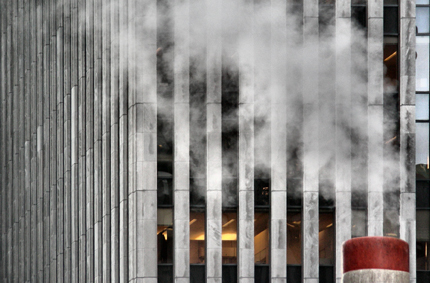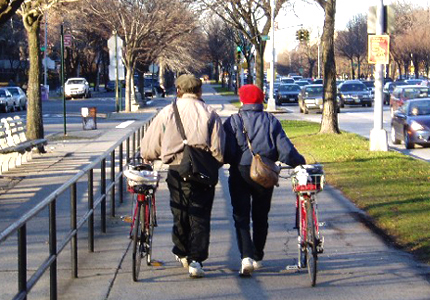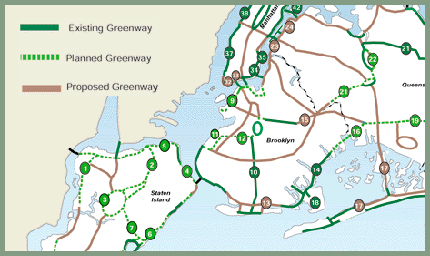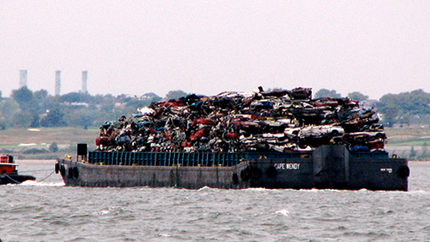Why a Bioheat Mandate?

Over the last year, New Yorkers have been led to believe that the worst thing they can do for the environment is drive their car. According to PlaNYC, cars and light trucks contribute approximately 17 percent of the city’s total carbon emissions, a number that will decrease considerably with the popularity of hybrid and alternative fuel vehicles.
However, a whopping 79 percent of New York City’s carbon dioxide emissions come from buildings -- from the burning of heating oil and natural gas. So environmentally speaking, the worst thing we can do is wait any longer for meaningful building emissions reforms, such as the bioheat and low sulfur heating mandate outlined in Intro 594.
One part of the building emissions problem well within our power to change at the local level is in the heating oil sector. The emergence of biodiesel -- a cleaner-burning, renewable energy source that is processed from plant and vegetable oils in the United States and is blended with diesel for use in trucks and blended with heating oil for use in buildings--has finally made this possible.
A Smart Solution
Bioheat, as this blend of heating oil and biodiesel is called, displaces up to 20 percent of petroleum-based heating oil with renewable “B100 biodiesel” that is made from vegetable or plant oils like soy or recycled restaurant grease.
A “B20 bioheat blend,” which is 20 percent renewable biodiesel, significantly reduces carbon emissions and fine particulate matter, a major contributor to asthma and one reason why parts of New York City have some of the highest asthma rates in the United States. My bill would require this blend be used throughout New York City, in both commercial and residential properties, by 2013.
Bioheat also reduces our dependence on foreign oil by displacing a significant amount of petroleum with a domestic product.
Bioheat seamlessly replaces heating oil in all boilers, requires no expensive modifications and is available today through at least a half dozen companies in the New York Metropolitan Area. Yet only a very small fraction of the 1.2 million heating oil households and commercial heating oil users burn bioheat.
An Immediate Solution
So why do we need Intro 594 to require that all heating oil buildings use bioheat? Because unless bioheat is mandated, we will be having this conversation 10 years from now, while more damage is done to our environment, more New Yorkers suffer from asthma and our dependence on foreign oil continues to be ignored.
That is not to say there aren’t many important questions that need to be addressed:
Cost: Currently, bioheat costs more than heating oil. That is why I sponsored City Council Resolution 1303, which urged the governor and the State Legislature to ensure the passage of a four-year Bioheat Tax Credit, which, fortunately, was adopted in the state budget. It goes a long way to bridging the cost gap for homeowners and residential landlords.
Supply: According to the National Biodiesel Board, in 2006, 250 million gallons of biodiesel were produced in the United States -- more than triple the amount produced in the previous year. And New York City will likely be host to a 110 million-gallon-capacity biodiesel processing facility -- a proposal by Metro Fuel Oil currently slated for Brooklyn, which could be one of the largest facilities in the country.
Equipment feasibility: B20 bioheat has been used in New York City for several years with no reported equipment problems. One of the largest heating oil equipment manufacturers in the country now warranties bioheat and with the ASTM International standards organization set to strengthen its commitment to bioheat this summer, all manufacturers will likely follow suit.
Sustainability: The primary feedstock used to produce biodiesel in the United States is soy. When processing soy for biodiesel, the food value -- which accounts for 80 percent of the soy bean -- is left untouched. Therefore, it is not a “food for fuel” issue. It is also plentiful, with the United States leading the world in soy exports for many years. Recent confusion on “biofuels,” which includes the more controversial ethanol, has led some to question all biofuels-- but the details are what are important. American-grown soy-based biodiesel has not been pegged as problematic. Plus, it is expected by many that in just a few years biodiesel will be made with oil made from algae which can be made cheaper and has higher yields.
A Feasible Solution
In the year since I held the first oversight hearing on the use of biofuels in New York City and then introduced Intro 594, I am proud to have witnessed a broad-based coalition of unlikely allies form around this bill and this issue.
In announcing the bill, environmental groups like Environmental Defense and health advocacy groups like the American Lung Association stood shoulder to shoulder with the New York Oil Heating Association and several heating oil companies. The New York League of Conservation Voters included the bioheat mandate in its 2008 New York City Policy Agenda and the Mayor’s Office of Long Term Planning and Sustainability testified in favor of Intro 594 at my committee’s hearing earlier this year.
There are some who think that New York should wait on a bioheat mandate; that we should wait for California to come out with a report on air emissions; wait for the economy to pick up; wait until a new technology emerges. If we wait long enough, we’ll come up with even more reasons to wait. At the peril of our health and environment, we have waited decades for the forces of science and technology to converge with commercial viability and political will to produce a more renewable, more domestic, cleaner, greener heating product.
The fact is there is no reason to wait. Like gasoline, heating oil is too integrated into our energy infrastructure to disappear any time soon. It is here today and it will be here tomorrow. My bill proposes the how--the only question remaining is when do we make heating oil cleaner, greener and more domestic?
That time is now.
Councilmember James Gennaro has represented District 24 in Queens since 2002. He chairs the council's Committee on Environmental Protection. Â
Jumpstarting the Greenways System

When Mayor Michael Bloomberg made his 2007 Earth Day speech announcing PlaNYC to reduce greenhouse emissions in New York City, scientists were predicting that the North Pole's ice cap would be almost fully melted by 2040. Now, just a year later, the predicted date of that event is 2015.
In contrast, New York City's greenways system, one of our best chances to dramatically reduce transportation emissions, is moving ahead at a glacial pace. Although PlaNYC calls for connections in the bicycle network, and while building a system of greenways has been city policy for more than 15 years, construction has been slow. Due to intransigence by the city Department of Transportation's engineers, greenway development seems to have ground to a halt. The question now is whether a new transportation commissioner will be able to move the glacier in the remaining 20 months of the Bloomberg administration.
The 350-mile city greenways system of pedestrian and cycling trails separated from roadways was to be developed mostly along parks, waterfronts, cemetery edges and other breaks in the street grid, and along parkway and railroad right-of-ways. Sheltered from traffic, the greenways would improve the safety of pollution-free transportation and encourage cycling by children. (Statistics indicate that a smaller percentage of youth are learning to ride bicycles, and surveys show that parental fear of traffic is the reason.)

Over the last 15 years, the New York City parks department has built new trails in parks in every borough, but not one mile to connect these trails has been built along a city street controlled by the city's Department of Transportation. Every effort by advocates and agency insiders to get the department to begin connecting the trails has been thwarted. For example, the Brooklyn Waterfront greenway became a street-widening project that eliminated the sidewalk that was to become the greenway. UN Plaza has been offered at least a dozen times as a way to connect the two segments of the Manhattan East River trail but that never happened.
For the greenway system to serve its purpose, the city must provide sheltered lanes to encourage fearful cyclists to cycle on roadways. Painting stripes on streets does not make a greenway. The city's greenways plan calls for separated trails with trees and landscaping to shield pedestrians from particulate pollution and with clear signage to direct cyclists.
What Needs to Be Done
After 15 years of fighting, I have come up with 10 steps to help the city make greenways a reality. These projects are on the agendas of greenway advocates around the city.
First Avenue first: A separate bike lane, modeled on the new Ninth Avenue lane, should be installed along First Avenue and United Nations Plaza to connect the two existing sections of the East River Greenway. This will give East Side commuters the same continuous off-street cycling option that thousands of New Yorkers who use the West Side greenway have had for years.
Not about Manhattan only: An additional separated bike lane should be installed as an interim greenway along the entire Queens and Brooklyn East River waterfront from Red Hook to Flushing Meadows Park.
The Staten Island commute: The almost completed Staten Island South Shore greenway should be connected to the Staten Island Ferry. Lightly trafficked streets can be easily reconfigured to complete this important commuter route.
Recognize opportunities for major improvement: Crotona Parkway and Southern Boulevard are two parallel streets in the Bronx that are separated by a park not much wider than a traffic island. Crotona Parkway should be reconfigured to discourage through traffic and to encourage bike traffic as proposed in a 10-year-old plan prepared by the Neighborhood Open Space Coalition and the Bronx Council for Environmental Quality.
Greenways are also walking trails: Greenways should be a priority in the Million Trees program and should feature benches and drinking fountains. Creating greened environments for walking is a national health priority since they will increase physical activity.
Make signage easy to follow: "Interim-greenway" signs should be installed along the entire 350-mile NYC Greenways route using the well-recognized and Art Commission-approved signage that has been in use in city parks for years.
Fast track improvements: Measures to protect cyclists from motorists should be implemented along the entire system including greened traffic islands. There should be a citywide strategy and policy for implementation rather than the failed and expensive piecemeal approach.
Put trails on key bridges: While much has been done to improve pedestrian and bike access to the East River bridges over the years, the Verrazano, Whitestone/Throgs Neck and Outerbridge/Goethals bridges continue to be dead ends. The attitude that cyclists can travel around inaccessible bridges and pedestrians can take a bus has to end.
Provide access to all bridges: Many smaller bridges are also inaccessible. The transportation department should inventory bridge access and see that all bridge access points are direct and easy to find.
Create long-distance greenways: A special effort should be made to complete long distance routes that feature the dramatic interplay between the built city and the natural world. The city's greenways would connect to the East Coast Greenway system stretching from Maine to Florida. New York's other long distance greenways include the Gateway Greenway, which connects Jamaica Bay to Sandy Hook, N.J.; and the Hudson River Greenway from Troy, N.Y. and the Erie Canal to the Battery. This would promote ecotourism in the region.
The Benefits of Greenways
There are a number of reasons to implement this program. Existing greenways are heavily utilized. The Hudson River Greenway, for example, is sometimes credited with kick-starting the current cycling renaissance in New York City. But this is not just a Manhattan phenomenon. National Park Service personnel have noted significant increases in cycling past Floyd Bennett Field in Brooklyn after a greenway link was built along Flatbush Avenue. The more people travel on greenways, whether by bicycle or on foot, the less energy they use, the less pollution they produce and the more healthy exercise they get.
The greenways system was meant to provide a travel alternative for New Yorkers. A disconnected series of isolated local park paths will not accomplish that. If PlaNYC2030's goals of drastically reducing greenhouse gas emissions from motor vehicles are to become a reality, the city will need to move quickly to put an alternative infrastructure in place.
Dave Lutz is the executive director of Friends of Gateway and Neighborhood Open Space Coalition, which works for a healthier, greener city.
For a guide to the city's greenways, click here. Â
Making Zero Waste Part of the Plan

significantly reduce New York City's carbon footprint.
Amid the pages and pages of ideas and proposals to move New York toward sustainability in PlaNYC, there is barely a mention of solid waste. Even though solid waste has a huge environmental impact, PlaNYC ignores both the problem and the new movement toward zero waste.
Meanwhile, the extension of the few, current, pilot-sized initiatives in the city's most recent long-term solid waste management plan will do little to prevent. It only tentatively addresses a small portion of the 40 percent of total waste of the waste stream that is the organics fraction. Just a tiny fraction of the sanitation department's more than $1 billion budget goes to waste prevention.
Other forward-thinking countries, states and communities have already set a goal of zero waste and are aggressively implementing programs, legislation and incentives to achieve it. Widely misunderstood, zero waste simply means that our discards are recycled, composted, reused or not created in the first place. None of these materials should be disposed of in incinerators or landfills or exported, as New York currently does with almost 85 percent of its waste.
The Impact of Garbage
PlaNYC showed the volume of greenhouse gases that cause global warming emitted from within the city's borders. Providing that information is a great accomplishment. But the report does not go far enough. It only counts the gases actually emitted in the city, ignoring all the greenhouse gases that result from producing products and packaging that New Yorkers use and from bringing those goods to us.
New York City's carbon footprint (the total amount of greenhouse gases produced to support human activities here) should extend to the activities and communities that supply and manufacture the things that we demand. Various estimates show that "upstream" impacts account for 70 percent of emissions caused by products and materials that eventually become waste. Logging, mining and manufacturing towns have a huge carbon footprint totally disproportionate to their populations. Much of it derives from goods they provide to us. Not taking responsibility for these carbon emissions is wrong also because we then have no impetus to innovate and pursue measures to reduce them (i.e., zero waste initiatives).
The report also ignores the carbon emissions and other impacts of getting rid of waste. It does not include the emission deriving from the disposal of New York City's waste at incinerators in Newark and elsewhere, in Pennsylvania and Virginia landfills or transporting the materials (most of which is recyclable, compostable and/or would not have to be created in the first place) to these facilities.
The city's carbon footprint report indicates that buildings create 79 percent of the carbon emissions, while solid waste was responsible for only 3 percent of the city's greenhouse gas emissions in 1995 when the Fresh Kills landfill was open and zero after that. For all the reasons mentioned, this is an inaccurate estimate.
The effects of landfills, the most common waste management practice used by New York City, are particularly damaging, according to the federal Environmental Protection Agency. "It results in the release of methane from the anaerobic decomposition of organic materials. Methane is 21 times more potent a GHG than carbon dioxide," the agency has found.
Incineration creates toxic ash that must be disposed of. Despite significant technological advances in reducing emissions of toxic gases, greenhouse gases are emitted from waste-to-energy plants, and the amount of energy they generate is less than the amount required to log, mine, manufacture and move new materials to replace them.
If the city were to acknowledge the environmental impacts of its residents' demand for goods and materials, it would have to take a much bolder approach to conserving materials than its does in its 2030 goals or solid waste management plan. Conversely, if we disassociate ourselves from the contributions that our demands for and disposal of products and packaging make to global warming, we will have no reason to reduce our consumption and increase reuse, recycling and composting.
Cutting Back on Waste
No method can reduce the environmental impacts of waste as much as waste prevention. New York State's Solid Waste Management Act of 1988 states that waste prevention is the most environmentally desirable option for dealing with solid waste. Recycling, reuse and composting are near the top of preferred methodologies.
Recognizing a need for a bolder vision, in 2004 a coalition of solid waste experts, including myself, wrote "Reaching for Zero: The Citizens' Plan for Zero Waste in New York City," a 200-page, 20-year plan. Each year is packed with innovative measures to maximize waste prevention, reuse, recycling and composting, and with associated economic development, education, enforcement, transportation, financing, legislation and research. It proposes specific short, mid and long-term tonnage goals, overall as well as for prevention, reuse, recycling and composting. The report recommends the creation of an extensive new reuse and composting collection and processing infrastructure and innovative pilot and research programs.
Examples of short-term measures to bolster reuse include 40 neighborhood swap shops, four reuse complexes and four material recovery facilities with a fleet of trucks. Mid-term examples include construction of anaerobic digestion facilities to convert 45 percent of the city's food, yard and soiled papers to biogas and an organic fertilizer product, which can be used elsewhere.
The plan calls for legislation to ban recyclables and compostables from export to landfills and incinerators and to require that manufacturers take back more products for repair and reuse. A "pay as you throw" billing system, used in 7,000 U.S. communities, would reward residents for recycling, composting and throwing out less waste and penalize wasters. As export is reduced, jobs in the local reuse, recycling and composting sectors would rise. Clearly, zero waste would have been a perfect framework for PlaNYC and the city's solid waste plan.
In 2005, I organized an environmental coalition to work with the Assembly to strengthen and modernize the state's Solid Waste Management Act so that local plans would have to adhere to practices aimed at achieving zero waste and that municipalities would actually implement all measures in those plans. (To read the coalition's legislative redraft and recommendations, click here.)
Here are specific recommendations for how the city can get closer to zero waste.
* Add a commitment to PlaNYC to ensure movement away from export, landfilling and incineration toward achieving zero waste disposal by 2030.
* Correct the city's carbon footprint inventory document to account for and take ownership of the greenhouse gases produced elsewhere as a result of demand and acquisition of materials by the city and its residents.
* Correct the city's solid waste management plan so that it adopts the measures recommended in "Reaching for Zero."
* Supply the funding necessary to implement the zero waste measures.
* Enact the modifications to the NYS Solid Waste Management Act of 1988 to modernize the policy goals to include zero waste and require that localities' plans include and that they implement a sufficient number and diversity of these measures.
Maggie Clarke of Maggie Clarke Environmental has a doctorate in earth and environmental sciences and is a long-time New York City-based solid waste scientist, researcher, educator, and activist.Â





